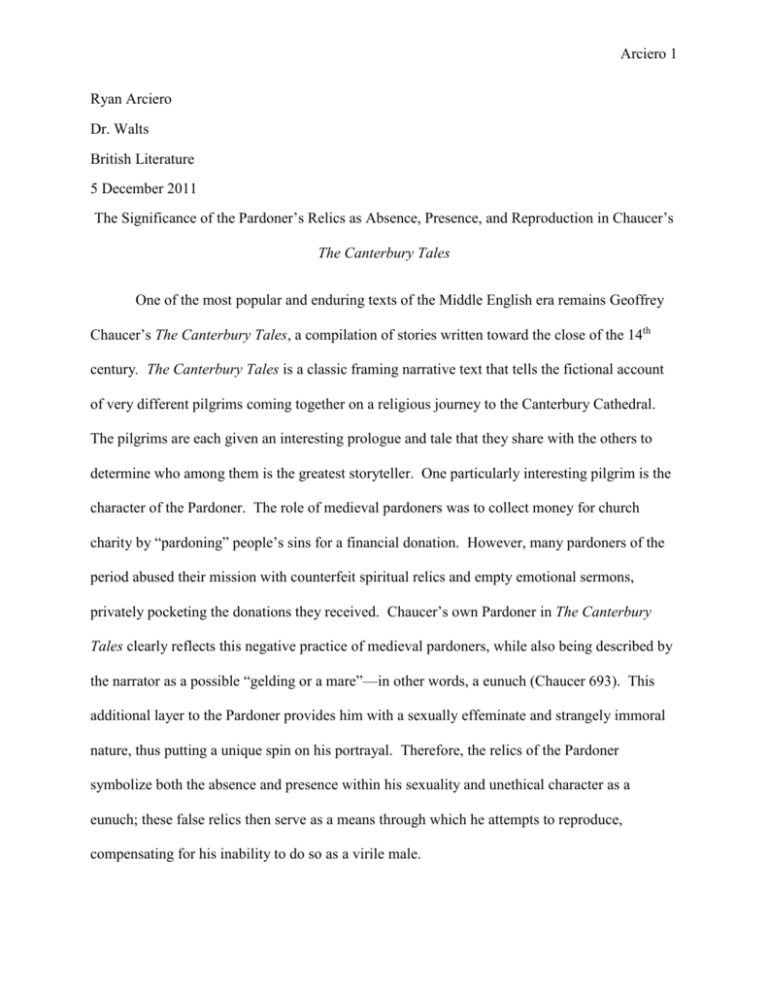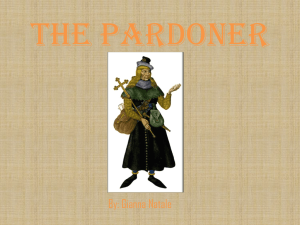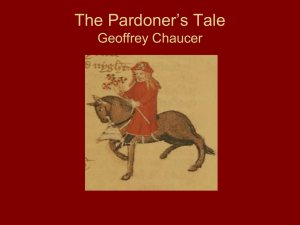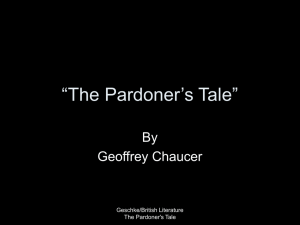Significance of the Pardoner`s Relics as Absence, Presence, and
advertisement

Arciero 1 Ryan Arciero Dr. Walts British Literature 5 December 2011 The Significance of the Pardoner’s Relics as Absence, Presence, and Reproduction in Chaucer’s The Canterbury Tales One of the most popular and enduring texts of the Middle English era remains Geoffrey Chaucer’s The Canterbury Tales, a compilation of stories written toward the close of the 14th century. The Canterbury Tales is a classic framing narrative text that tells the fictional account of very different pilgrims coming together on a religious journey to the Canterbury Cathedral. The pilgrims are each given an interesting prologue and tale that they share with the others to determine who among them is the greatest storyteller. One particularly interesting pilgrim is the character of the Pardoner. The role of medieval pardoners was to collect money for church charity by “pardoning” people’s sins for a financial donation. However, many pardoners of the period abused their mission with counterfeit spiritual relics and empty emotional sermons, privately pocketing the donations they received. Chaucer’s own Pardoner in The Canterbury Tales clearly reflects this negative practice of medieval pardoners, while also being described by the narrator as a possible “gelding or a mare”—in other words, a eunuch (Chaucer 693). This additional layer to the Pardoner provides him with a sexually effeminate and strangely immoral nature, thus putting a unique spin on his portrayal. Therefore, the relics of the Pardoner symbolize both the absence and presence within his sexuality and unethical character as a eunuch; these false relics then serve as a means through which he attempts to reproduce, compensating for his inability to do so as a virile male. Arciero 2 From the very beginning of The Canterbury Tales, the narrator provides readers with a detailed depiction of the Pardoner’s attributes. “This Pardoner hadde heer as yelow as wex, But smoothe it heeng as dooth a strike of flex… A vois he hadde as smal as hath a goot; No beerde hadde he” (Chaucer 677-678). These lines render the Pardoner in a rather negative light—his blonde hair is not described as fair or lustrous, but instead as yellow and waxy, both unpleasant descriptions. Similarly, his probable condition as a eunuch is quickly noted; the lack of a beard and high-pitched voice are both naturally feminine features. In character with his occupation, the Pardoner is also depicted according to his relics—the materials he carries with him as token remissions of sin—are also given much attention. From “pigges bones” to bits and pieces of pious saints, the Pardoner keeps many of his supposedly religious artifacts “All trussed up in his wallet” (Chaucer 683, 703). However, his relics are little more than a charade; they are merely material objects the Pardoner has picked up as a means for him to make money off of others through their “repentance.” When one examines both the narrator’s unwholesome portrayal of the character to the false artifacts he carries with him, it becomes evident that the Pardoner’s disagreeable physical description matches the artificial relics he prizes. Despite the Pardoner having such a distasteful air about him, it nonetheless becomes evident to the reader that the Pardoner cares very much about his appearance. Yet like the ostentatious value but inner hollowness of his relics, Chaucer’s lines in “The General Prologue” reveal very early on that the Pardoner is not what he seems. While the Pardoner may be somewhat successful in making himself believe that he looks masculine and imposing, The Canterbury Tales’ narrator immediately notes him as a “sexually peculiar figure”—one that has “carefully styled but lifeless hair” and a “hairless face… that proclaims the unfortunate facts of his anatomy” (Dinshaw 567). Yet again, the Pardoner’s hair in particular serves as a solid Arciero 3 paradigm that reflects what the Pardoner wants to look like to others is not what really exists below the surface. For example, regardless of its thin appearance, the styling the Pardoner has done attempting to make his hair look smooth and shiny reveals the importance he places into maintaining his masculine façade. Yet try as he might to make his hair appear glossy, he cannot fool the pilgrims of its dull color and waxy form—just as he cannot fool them into thinking that he is very masculine or affluent. Even concerning the “designer” cloak he pretentiously wears, the narrator comments that “The Pardoner is as clothes-conscious as is the Wife of Bath” (Dinshaw 567). All of these qualities point to the noteworthy idea that the Pardoner is not only effeminate, but also very preoccupied with his physical appearance and presentation, rather than the religious impression he makes (which would normally be expected from a figure of the church). “The Pardoner’s Tale,” a story with the theme that avarice leads to devastation for all involved, grippingly reflects the very amoral and self-interested character of the Pardoner himself. The Pardoner’s narrative tells the fictional account of three men that try to greedily deceive each other and end up dying in the process—“Thise riotoures three of whiche I telle, Longe erst er prime ronge of any belle, Were set hem in a taverne to drinke” (Chaucer 373-375). While intoxicated with alcohol (a vice that the Pardoner similarly takes part in), the three men find a hoard of treasure in their search to locate the embodiment of Death. After sending the youngest of the three away to town, the other two travelers decide they will kill him upon his return and share the spoils. However, the youngest man has a similar idea, thinking, “’O Lord,’ quote he, ‘if so were that I mighte Have al this tresor to myself alone’” (Chaucer 543-544). Upon bringing poisonous wine back for the others, the youngest man is promptly killed; after the other two men unknowingly drink the lethal wine, they too die. The Pardoner closes his tale by Arciero 4 condescendingly commenting that the greed of the travelers was their ultimate downfall. What is so ironic about the Pardoner’s statement is that he is little better than the men in his story. As one who consistently deceives innocent people and takes all of their monetary donations for himself, he is hardly in a place to pass judgment. Like “The Pardoner’s Tale” itself, the underlying theme of the Pardoner’s account offers insight into his morally absent nature. While speaking to the other pilgrims during his “Prologue,” The Pardoner divulges that before selling his relics, he tells a story that always follows the important subject of Radix malorum est cupiditas—“Avarice is the root of all evil.” “My theme is always oon, and evere was: Radix malorum est cupiditas… And folk shal have no power ne no grace, To offren to my relikes in this place” (Chaucer 45-46, 95-96). Not only is the Pardoner’s statement mocking in that he does not practice the moral that he preaches, but his avariciousness is actually one of his most glaringly evident qualities. Without any pretense of guilt or shame for his actions, the Pardoner informs the other pilgrims that he relishes the riches that he makes from using his false relics. In fact, the Pardoner is so morally crooked that he would take everything from even the poorest of individuals to maintain the well-to-do lifestyle he is accustomed to: “I wol have moneye, wolle, cheese, and whete, Al were it yiven of the pooreste page, Or of the poorest widwe in a village—Al sholde hir children starve for famine” (Chaucer 160-163). The later lines in which the Pardoner states that corrupt or antireligious people have neither the right nor refinement to advertise spiritual objects further make him out to be little more than a hypocrite. The Pardoner blatantly claims that only ethically sound and righteous people should have the privilege to manage and sell sacred relics to those in need of them—yet in actuality, the Pardoner himself is neither ethical nor righteous. Arciero 5 In addition to examining the Pardoner as a morally absent figure, it is also worthwhile to view the presence of the Pardoner as a eunuch when considering his character. Being a eunuch, the relic-offering Pardoner is anatomically missing his male genitalia. It thus becomes reasonable to reflect on the interesting idea that the Pardoner uses his relics as a way of trying to make himself “whole” once again. As Carolyn Dinshaw notes in her “Eunuch Hermeneutics” article, “The Pardoner surrounds himself with objects—relics, sealed documents… But these objects are themselves only fragments, and cannot properly fill the lack that hollows the Pardoner’s being” (568). Supposedly religious relics of the Middle Ages were often considered to be bits and pieces of holy artifacts or even saints’ body parts, much like the “precious” objects that are described being carried by the Pardoner. Indeed, “Private collectors and pardoners alike, from the very early years of Christianity, were greedy for [the relics] and the great value behind them… But it was this very practice of fragmentation that led to widespread frauds” (Dinshaw 572). It is therefore these fragmented relics that contribute toward making the Pardoner the fraud that he is, but nevertheless give him the means through which he is able to try to feel intact, despite being a eunuch. However, it is equally important to realize that as only scraps or parts of a once complete entity, the Pardoner’s relics are in fact fragments themselves, both literally and figuratively (much like the Pardoner himself). In a literal sense, just as the Pardoner is missing the sexual body parts of whom he is, so too are separated relics divided from their initial state of completeness. Figuratively, these relics serve as symbols of fragmentation, or the lack of a significantly whole being or object. Yet the money that the Pardoner gleans from abusing his pardoning role and relics enable him to gratify his greedy need for riches and fullness. He does not care to use his false objects for good, but rather to selfishly indulge his cravings—“Which Arciero 6 that I use, and that is avarice. But though myself be gilty in that sinne… From avarice and sore to repente—But that is nat my principal entente: I preche no thing but for coveitise” (Chaucer 140145). This avariciousness consequently leaves the relics lacking any spiritual consequence or gravity. As a eunuch, the Pardoner similarly feels incomplete and lacking; his partial relics reflect the partialness that exists within his sense of self. While the Pardoner evidently attempts to compensate for his fragmented being by “filling” his missing parts with the artifacts he carries with him (as well as the money and prominence he gains from them), they fail in adequately satisfying the void the Pardoner is afflicted by. “Even though the Pardoner knows that his relics, documents, words are defective substitutes—they are fakes—he holds on to the belief that they can make him whole, part of the body of pilgrims, and of the larger body of Christians” (Dinshaw 568). In many ways, the Pardoner and his relics are comparable; each signifies an intricate dichotomy of physical, moral, and sexual presence and absence. Just as the relics symbolize a corporeal presence on the surface but an absence of meaning underneath, so too does the Pardoner himself try to ostentatiously appear ethical and masculine, but lacks integrity and virility within. As a eunuch, the Pardoner attempts to guise his missing body parts with a veneer of spirituality; in reality, however, it is his physical nature that the Pardoner concentrates all of his attention to. “Chaucer’s eunuch, the Pardoner, has an extraordinary focus on the body in his Prologue and Tale. He is preoccupied by, and chained to, the flesh, never rising out of it to reach the spirit… revealing an unjust world—a castrated world” (Dinshaw 569-570). The Pardoner is someone who clings to material gain and worth—an individual that cannot serve as a religious figure because he is far too consumed with a physical façade. In abusing his church position, the Pardoner seems to take out his inner pain and anger at being a eunuch on others by Arciero 7 deceiving them. Even after letting the pilgrims know he’s a fraud, he still goes on to encourage them to “repent” with money—“But sires, oo word forgat I in my tale, I have relikes and pardon in my male… If any of you wol of devocioiun, Offren and han myn absolocioun” (Chaucer 631636). While the eunuch Pardoner may use his counterfeit objects as a means of further emphasizing his corporeal nature (with the outward semblance of “religious” artifacts), in reality he does little more than continue to “cut himself off” from the pilgrims he encounters. While the relics of the eunuch Pardoner certainly do parallel the absence and presence with his character, they serve another significant purpose—a means of reproduction. Being a eunuch, the Pardoner lacks masculine defining features and a natural way to have children. It is therefore interesting to consider the idea that the Pardoner attempts to compensate for this deficiency by using his relics as a substitute for procreation. Since “[The Pardoner] can’t increase and multiply literally or spiritually… he is forced to use the proliferating relics as the means by which he unnaturally increases and multiplies” (Dinshaw 573). This notion of desiring what one cannot have—in the Pardoner’s case, a socially accepted sexual relationship and the ability to produce offspring—is echoed by the other pilgrims. Just as all of the pilgrims are in a sense going on the pilgrimage to find that something that will make them feel complete or fulfilled, so too can the Pardoner be considered an individual trying to find fulfillment in his own life through his relics. Although the other pilgrims can physically reveal their sexual potency and proclivity (as evidenced by the Knight’s son, the Squire, and the lusty Wife of Bath), the eunuch Pardoner is unable to do so. Consequently, the Pardoner is forced to try to procreate by spreading his relics—“the scraps and chips of saints that substitute for his lack of natural virility” (Dinshaw 571). Nonetheless, just as it fails to fool the other pilgrims, the Pardoner’s attempt at “reproducing” (leaving a legacy or tangible entity behind) is ultimately unsuccessful. The false Arciero 8 and fragmented relics cannot sufficiently compensate for the Pardoner’s lack of genitalia, high status, or moral character. In summary, the eunuch Pardoner’s relics are an integrally connected part of his very character; they symbolize both the absence and presence within his being, as well as signs of his only means of reproduction. During his description and dialogue in The Canterbury Tales, readers can notice that the Pardoner attempts to find a balance between this absence and presence of morality, this lack of virility, and this hope for sexual wholeness through his precious relics. However, Carolyn Dinshaw notes in “Eunuch Hermeneutics” that “because of the loss of the idea of completion, the castrated subject [the Pardoner] forever seeks the realm of original fullness, but must be content with substitutes only partially sufficient” (Dinshaw 574). Despite his best efforts, the Pardoner’s hollow sermons and carefully styled surface cannot compensate for what he does not have. His outward presence of faked spirituality, sexuality, and grandeur do little overall to mask the triviality and hypocrisy of both the relics and the Pardoner underneath. Chaucer’s Pardoner can be viewed as an unfortunate figure among the pilgrims—one that is too blinded by greed to realize that his pretense dupes no one. In the same way that the Pardoner cannot truly pass himself off as a fully masculine individual, spiritual figure, or even as an affluent churchman, he similarly fails in deceiving himself. Ultimately, his hope that the relics will give him the gratification he craves “remains but a dream that can never be fully satisfied” (Dinshaw 567). Thus, his life and work as a pardoner appear to readers as a futile pursuit for approval. Yet due to his immoral behavior and physical condition as a eunuch, he can never achieve the sense of wholeness he is searching for. It does not cross the Pardoner’s mind that if he truly did try to encourage and inspire others with his religious sermons, he might actually “reproduce” and find fulfillment through the spiritual messages he leaves behind. Arciero 9 Works Cited Chaucer, Geoffrey. The Canterbury Tales. The Norton Anthology of English Literature: Eighth Edition, Volume A. New York: W.W. Norton, 2006. Pp. 235-298. Dinshaw, Carolyn. “Eunuch Hermeneutics.” Chaucer’s Sexual Poetics. Madison: University of Wisconsin Press, 1989. Pp. 156-184.








